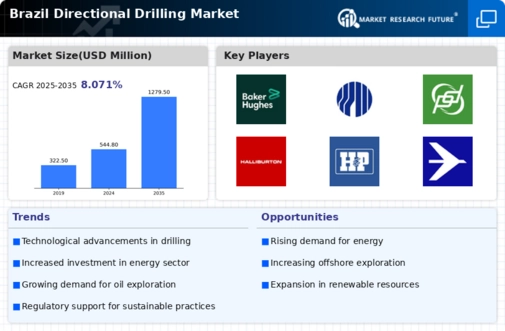Rising Energy Demand
The increasing energy demand in Brazil is a primary driver for the directional drilling market. As the country seeks to enhance its energy security and reduce reliance on imports, the need for efficient extraction methods becomes paramount. The Brazilian government has set ambitious targets for oil and gas production, aiming to increase output by 30% by 2030. This surge in demand for energy resources necessitates advanced drilling techniques, particularly directional drilling, which allows for more precise targeting of reserves. The directional drilling market is expected to benefit from this trend. Operators look to optimize production and minimize costs. Furthermore, the growing interest in renewable energy sources may also lead to increased exploration activities, further propelling the market forward.
Technological Innovations
Technological innovations are significantly influencing the directional drilling market in Brazil. The introduction of advanced drilling technologies, such as rotary steerable systems and real-time data analytics, enhances drilling efficiency and accuracy. These innovations allow operators to navigate complex geological formations with greater precision, reducing drilling time and costs. According to industry reports, the adoption of such technologies can lead to a reduction in drilling costs by up to 20%. As Brazilian companies increasingly invest in these cutting-edge technologies, the directional drilling market is poised for growth. The ability to drill deeper and more accurately not only improves resource recovery but also minimizes environmental impact, aligning with the industry's evolving standards.
Investment in Infrastructure
Investment in infrastructure development in Brazil plays a crucial role in driving the directional drilling market. The government has initiated several projects aimed at improving transportation and logistics, which are essential for the efficient operation of drilling activities. For instance, the National Logistics Plan outlines investments of over $30 billion in infrastructure by 2025, which includes enhancements to ports and roads that facilitate the movement of drilling equipment and personnel. This improved infrastructure not only reduces operational costs but also enhances the overall efficiency of drilling operations. As a result, The directional drilling market is likely to see increased activity. Companies will capitalize on these developments to expand their operations and improve their competitive edge.
Increased Exploration Activities
Increased exploration activities in Brazil are driving the directional drilling market as companies seek to tap into untapped reserves. The Brazilian oil and gas sector has seen a resurgence in exploration efforts, particularly in offshore areas such as the pre-salt layer, which is estimated to hold vast reserves. The government has been proactive in auctioning exploration rights, attracting both domestic and international investments. This heightened interest in exploration is likely to lead to a greater demand for directional drilling services, as these techniques are essential for accessing challenging reserves. The directional drilling market is expected to expand as operators strive to maximize recovery rates and optimize their drilling strategies in these promising areas.
Regulatory Framework Enhancements
Enhancements in the regulatory framework governing the oil and gas sector in Brazil are influencing the directional drilling market. The government has implemented reforms aimed at streamlining the permitting process and reducing bureaucratic hurdles for drilling operations. These changes are designed to attract foreign investment and promote technological advancements in the sector. As a result, companies are more inclined to invest in directional drilling technologies, which are often more efficient and environmentally friendly. The regulatory environment appears to be becoming increasingly favorable for the directional drilling market, potentially leading to a surge in new projects and increased competition among service providers.




















Leave a Comment